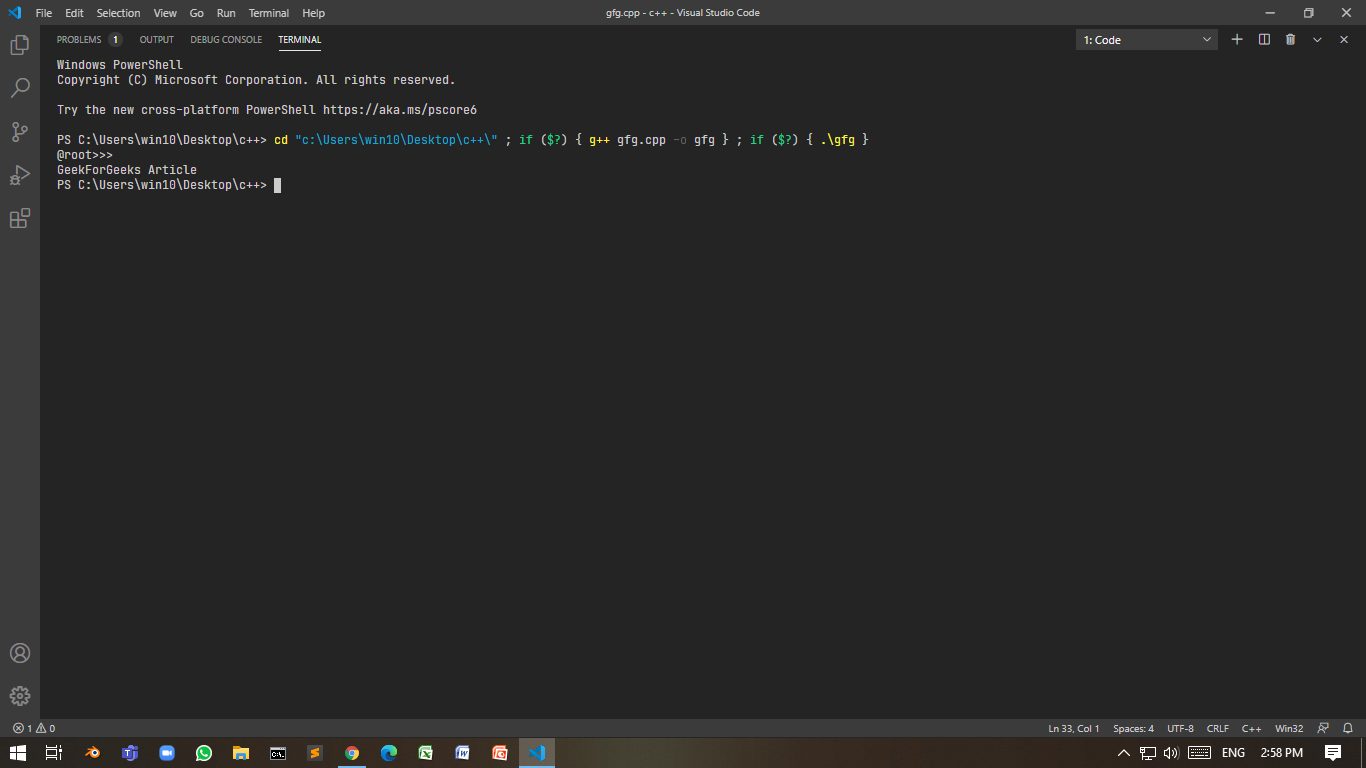有两种方法可以更安全地进行输入:
- 不显示任何内容。
- 显示特殊字符(例如星号)而不是实际内容。
在这种方法中,输入内容将是不可见的。这可以通过两种方式实现:
使用
程序1:
下面是将控制台模式设置为启用,回显输入和重置控制台模式的程序:
C++
// C++ program to take the input
// invisibly
#include
#include
using namespace std;
// Function take password and
// reset to console mode
std::string takePasswdFromUser()
{
HANDLE hStdInput
= GetStdHandle(STD_INPUT_HANDLE);
DWORD mode = 0;
// Create a restore point Mode
// is know 503
GetConsoleMode(hStdInput, &mode);
// Enable echo input
// set to 499
SetConsoleMode(
hStdInput,
mode & (~ENABLE_ECHO_INPUT));
// Take input
string ipt;
getline(cin, ipt);
// Otherwise next cout will print
// into the same line
cout << endl;
// Restore the mode
SetConsoleMode(hStdInput, mode);
return ipt;
}
// Driver Code
int main()
{
string input;
cout << "@root>>> ";
// Function Call
input = takePasswdFromUser();
// Print the input
cout << input << endl;
} C++
// C++ program to demonstrate the
// use of getch()
#include
#include
using namespace std;
// Function using getch()
std::string takePasswdFromUser()
{
string ipt = "";
char ipt_ch;
while (true) {
ipt_ch = getch();
// Check whether user enters
// a special non-printable
// character
if (ipt_ch < 32) {
cout << endl;
return ipt;
}
ipt.push_back(ipt_ch);
}
}
// Driver Code
int main()
{
string input;
cout << "@root>>> ";
// Funciton call
input = takePasswdFromUser();
cout << input << endl;
} C++
// C++ program to demonstrate the
// solution of above drawback
#include
#include
using namespace std;
// Enumerator
enum TT_Input {
// ASCII code of backspace is 8
BACKSPACE = 8,
RETURN = 32
};
// Function accepting password
std::string takePasswdFromUser()
{
string ipt = "";
char ipt_ch;
while (true) {
ipt_ch = getch();
if (ipt_ch < TT_Input::RETURN
&& ipt_ch != TT_Input::BACKSPACE) {
cout << endl;
return ipt;
}
// Check whether the user
// pressed backspace
if (ipt_ch == TT_Input::BACKSPACE) {
// Check if ipt is empty or not
if (ipt.length() == 0)
continue;
else {
// Removes last character
ipt.pop_back();
continue;
}
}
ipt.push_back(ipt_ch);
}
}
// Driver Code
int main()
{
string input;
cout << "@root>>> ";
// Function call
input = takePasswdFromUser();
cout << input << endl;
} C++
// C++ program to hide the password
// using *(asterik)
#include
#include
using namespace std;
// Enumerator
enum IN {
// 13 is ASCII for carriage
// return
IN_BACK = 8,
IN_RET = 13
};
// Function that accepts the password
std::string takePasswdFromUser(
char sp = '*')
{
// Stores the password
string passwd = "";
char ch_ipt;
// Until condition is true
while (true) {
ch_ipt = getch();
// if the ch_ipt
if (ch_ipt == IN::IN_RET) {
cout << endl;
return passwd;
}
else if (ch_ipt == IN::IN_BACK
&& passwd.length() != 0) {
passwd.pop_back();
// Cout statement is very
// important as it will erase
// previously printed character
cout << "\b \b";
continue;
}
// Without using this, program
// will crash as \b can't be
// print in beginning of line
else if (ch_ipt == IN::IN_BACK
&& passwd.length() == 0) {
continue;
}
passwd.push_back(ch_ipt);
cout << sp;
}
}
// Driver Code
int main()
{
string input;
cout << "@root>>> ";
// Function call
input = takePasswdFromUser();
cout << input << endl;
} 输出:

使用< conio.h > :
为此,使用了getch()。该函数从用户那里输入没有缓冲的字符,并且不等待用户按下“返回”键。
程式2:
下面是C++程序,用于演示conio.h中getch()的用法:
C++
// C++ program to demonstrate the
// use of getch()
#include
#include
using namespace std;
// Function using getch()
std::string takePasswdFromUser()
{
string ipt = "";
char ipt_ch;
while (true) {
ipt_ch = getch();
// Check whether user enters
// a special non-printable
// character
if (ipt_ch < 32) {
cout << endl;
return ipt;
}
ipt.push_back(ipt_ch);
}
}
// Driver Code
int main()
{
string input;
cout << "@root>>> ";
// Funciton call
input = takePasswdFromUser();
cout << input << endl;
}
输出:

缺点:用户无法清除之前做出的响应。当按退格键时,将返回输入。
程序3:
下面是C++程序,用于演示针对上述缺陷的解决方案:
C++
// C++ program to demonstrate the
// solution of above drawback
#include
#include
using namespace std;
// Enumerator
enum TT_Input {
// ASCII code of backspace is 8
BACKSPACE = 8,
RETURN = 32
};
// Function accepting password
std::string takePasswdFromUser()
{
string ipt = "";
char ipt_ch;
while (true) {
ipt_ch = getch();
if (ipt_ch < TT_Input::RETURN
&& ipt_ch != TT_Input::BACKSPACE) {
cout << endl;
return ipt;
}
// Check whether the user
// pressed backspace
if (ipt_ch == TT_Input::BACKSPACE) {
// Check if ipt is empty or not
if (ipt.length() == 0)
continue;
else {
// Removes last character
ipt.pop_back();
continue;
}
}
ipt.push_back(ipt_ch);
}
}
// Driver Code
int main()
{
string input;
cout << "@root>>> ";
// Function call
input = takePasswdFromUser();
cout << input << endl;
}

用特殊字符(*)隐藏密码:
这个想法是在这里使用库
计划4:
C++
// C++ program to hide the password
// using *(asterik)
#include
#include
using namespace std;
// Enumerator
enum IN {
// 13 is ASCII for carriage
// return
IN_BACK = 8,
IN_RET = 13
};
// Function that accepts the password
std::string takePasswdFromUser(
char sp = '*')
{
// Stores the password
string passwd = "";
char ch_ipt;
// Until condition is true
while (true) {
ch_ipt = getch();
// if the ch_ipt
if (ch_ipt == IN::IN_RET) {
cout << endl;
return passwd;
}
else if (ch_ipt == IN::IN_BACK
&& passwd.length() != 0) {
passwd.pop_back();
// Cout statement is very
// important as it will erase
// previously printed character
cout << "\b \b";
continue;
}
// Without using this, program
// will crash as \b can't be
// print in beginning of line
else if (ch_ipt == IN::IN_BACK
&& passwd.length() == 0) {
continue;
}
passwd.push_back(ch_ipt);
cout << sp;
}
}
// Driver Code
int main()
{
string input;
cout << "@root>>> ";
// Function call
input = takePasswdFromUser();
cout << input << endl;
}

要从最佳影片策划和实践问题去学习,检查了C++基础课程为基础,以先进的C++和C++ STL课程基础加上STL。要完成从学习语言到DS Algo等的更多准备工作,请参阅“完整面试准备课程” 。